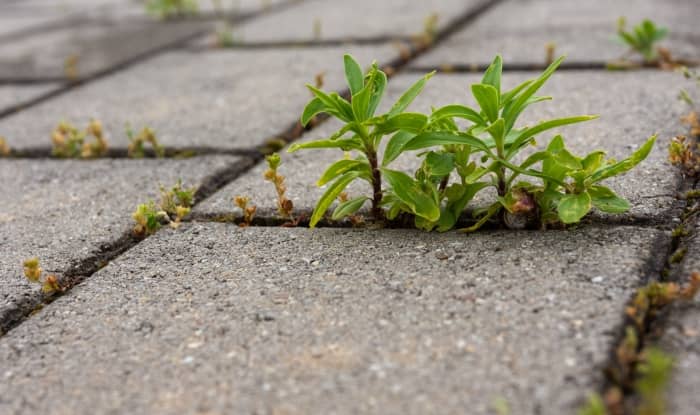No matter how correctly you place your pavers, weeds eventually will grow through the cracks.
Removing them can seem like a challenge. But fortunately, there are many cheap and effective methods that can help you take care of the problem.
All it takes is a little bit of planning and regular maintenance.
So let’s take a closer look at how to kill weeds between pavers.
How To Kill Weeds Between Pavers

You can try all of the methods here on their own. But sometimes you’ll have the best results by combining more than one.
Pull Weeds Out By Hand
Pulling weeds is often the first method people turn to because it doesn’t require any preparation. But it’s also one of the most time-consuming.
The main problem with pulling weeds out of cracks is that it can be hard to get a good grip. And they often break off without removing the root.
This means the weeds will grow back again. So you’ll need to pull weeds regularly to keep them under control.
It also means a lot of time on your hands and knees on the hard surface of your patio, pathway, or sidewalk.
Wearing gloves when pulling weeds can protect your fingers from any sharp edges. But if you want to make the job even easier, then consider getting the right tool.
Use A Weeding Tool
There are many weeding tools to help you pull weeds, grass, and moss, out of the cracks between pavers.
The best tools have a narrow edge that can get between the pavers. And a hooked end to help you lift out the weeds.
It’s a lot quicker than just using your hands. And their advantages don’t stop there:
They also make it easier to excavate the roots to prevent the weeds from growing back. So you won’t have to weed as often.
And it’s far more comfortable than trying to use your fingers.
These versatile tools are also useful for weeding other parts of your garden. Examples include V-notch weeders, Cape Cod crack weeders, and patio knives.
Use Weed Killer
Using a herbicide well-suited for use between pavers is one of the simplest ways to kill weeds and also one of the most effective.
For killing weeds growing between pavers you need a post-emergent herbicide. It’s also worth choosing one that’s non-selective. This will kill any plants that are growing in the cracks. But be careful not to spray it on plants you want to keep.
Get a systemic weed killer that will kill the weeds to the root and you won’t have to worry about the plant growing back again. And some chemical weed killers have a residual activity that can prevent vegetation from sprouting in the treated area for up to a year.
You can also get pre-emergent herbicides to prevent weed seeds from germinating in the cracks.
Not everyone likes spraying chemicals in their yard. But if you’re just killing the weeds between pavers then you’ll only have to use a small amount now and again.
Dehydrate Them With Salt
Most plants struggle to grow in salinated soil. And weeds are no exception.
The method is simple. Mix a cup of salt in a gallon of water. Then pour the saline solution into the cracks between your pavers.
But there are drawbacks to this method:
Rainfall and irrigation can lead to runoff and the salination of nearby areas of soil which will kill desirable plants.
And it’s possible for salt to damage your pavers. So be careful when using it.
Burn Them With A Weed Torch
A quick and easy way to kill the tufts of weeds that are sticking up through your pavers is to use heat.
With a propane weed torch, you can direct a short flame that incinerates the weeds upon contact.
One advantage of this method is that you can stand while you work. So you don’t have to get down on your hands and knees.
But as it doesn’t kill the roots the weeds will often regrow. So you’ll need to do the job regularly.
Cover The Weeds In Baking Soda
Another household item you can use to kill weeds between pavers is baking soda.
It works in a similar way to salt, causing the plant to dehydrate.
First, wet the weeds with water. Then sprinkle baking soda over them and into the cracks between your patio, driveway, or garden path.
Repeat after a few weeks if the weeds are still alive.
Also similar to salt, it can kill other plants when spread through runoff.
Kill Them With Boiling Water
One of the cheapest methods you can use to kill weeds between paving stones is to douse them in boiling water.
Obviously, great care is needed while using it, as it’s one of the more dangerous methods.
Pour it slowly into the cracks between your interlocking bricks or travertine pavers and over the weeds. Making sure no children or animals are stood nearby.
And wear the right protective gear to prevent any splashes from scalding you, such as long pants and shoes.
Boiling water can completely kill weeds with a root system near the top of the soil, preventing them from regrowing. But weeds with deeper roots are likely to grow back again.
Boiling water damages any plants it comes into contact with, so keep it away from desirable plants.
Soak The Weeds In Bleach
Bleach is an effective homemade weed killer that’s easy to use. It dries out the weeds causing them to die. And makes the soil inhospitable to plant growth.
For the best results, pour undiluted bleach into the paving cracks. It might not kill the weeds after one application. So be prepared to repeat it if you notice they’re still alive.
Once the plants die you can use a tool to pull them out of the ground for disposal.
Spray The Weeds With Vinegar
High concentration vinegar of around 20% acetic acid is a great weed killer.
To make it even more effective, you can mix it with dish soap in a weed killer sprayer before you spray the weeds.
Vinegar kills weeds naturally and organically, but it also has drawbacks. So you have to be very careful when using it to kill weeds between pavers.
Firstly, high-strength vinegar can damage your pavers. So you either need to be very precise when spraying the weeds, covering up your pavers with cardboard around the target area. Or be ready to wash the pavers with water in areas of overspray.
And secondly, high-strength vinegar can burn if it gets on your skin. So be careful when using it and wear protective clothing.
It also kills desirable plants. So be careful using it around the edges of your lawn.
Vinegar works quickly, with results often noticeable within hours. But, it doesn’t kill the roots of the weeds. So they sometimes grow back again.
Remove Weeds With Your Pressure Washer
Do you have a pressure washer?
If so, this is another way you can put it to good use.
But make sure you use a suitable attachment or nozzle so that you don’t cause any damage to the paving stones.
A jet nozzle can create noticeable markings. So it’s a better idea to change to a fan nozzle before removing weeds or cleaning the area.
Another option is to attach a rotating surface cleaner. This will do the job of cleaning your hardscapes and removing weeds simultaneously.
How To Stop Weeds Growing Between Pavers
After you’ve got rid of them you’ll want to prevent weeds growing back.
It’s a good idea to make sure the paving stones are properly installed to begin with. This limits the opportunity for weeds to grow between the cracks.
But dirt will still get between the pavers and build up. And weed seeds that get blown or washed into the dirt will germinate and start to grow.
To prevent this, you can pour polymeric sand into any gaps. This replaces the sand that’s been lost over time. It can also smother any leftover weed roots that were growing there.
To get the best results, you should also seal your patio, driveway, or walkway, after you resand.


